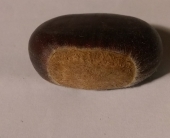


Rick Valley wrote:It interests me how many riparian species coppice well (Riparia is the Roman Goddess of rivers) Could it be that beavers selected for species that regrow? Anyway, my favorite alder is Italian- they do fine on dryland sites or on a river bank and they coppice well, and tolerate urban soils which often have abundant lime (from concrete) Maples that are great for coppice include Vine Maple and Big Leaf Maple. Osage Orange is in the Mulberry Family and is horribly spiny, but one badass tough drought tolerant coppice tree with mega-hard wood, that powered Comanche military dominance because it makes awesome bows, good for hunting buffalo or invading Spaniards, which originated the mongrel common name "Bodark" from from French "Bois D'Arc" or "bow wood" in "Merakin" Now I'ma have to see if there's a You Tube of the song "Choctaw Bingo"... with the line "Like an Ol' Bodark Fence Post You Could Hang A Pipe Rail Gate From" If you've never heard it, it is my Favorite Country song. It has been proposed that the Osage Orange fruit was a dispersal mechanism which appealed to the tastes of some now-extinct mega fauna.
So ANYTHING cellulosic can burn, but woods that have elite properties can really make you some bank ($) and the scrap can be firewood, is how I feel about it. When I am living with wood heat, I get paid to cut my firewood: How's that work you say? When I lived in Portland I heated my place with trimmings off of Cherry Laurel hedges, very good Hardwood, and in pieces that don't need splitting.







paul wheaton wrote:
Don Dufresne wrote: I'm curious as to how a RMH works with poplar. Is there a build up of creosote?
Rocket mass heaters don't have creosote. A rocket mass heater tries to create a "chimney fire" every burn. The chimney (or "heat riser") looks spotlessly clean every inspection.

S. G. Botsford wrote:
I don't see a half cord as being impossible. I'm in Alberta near Edmonton. We have a similar climate to the plains area of Montana -- what Montana gains by being south of us, they lose due to higher elevation. We run a heating season of about 10,000 degree F days per year.
We have a 2500 square foot house that is mostly heated with a moderate efficiency (80%) airtight steel stove, and a low efficiency century old cast iron wood/coal range. (we do not burn coal in it.) We burn about 3 cords a year.
Paul is gaining a factor of 2 in efficiency by using a rocket mass heater. Montana isn't as dark as Alberta in the winter. Longer winter days give him another, what 20-30%.
Wood energy is directly proportional to dry weight. Hardwoods tend to be denser than softwoods, but larch or tamarack is more dense than poplar. Spruce and poplar is about the same.
Drying time is important. I now have covered storage for 16 cords. I figure 4 cords a year, but usually don't burn that much unless it is a bitter winter.
I burn mostly poplar. Not a lot of heat per cord, compared to other hardwoods, but it's fast to cut and fast to split.


